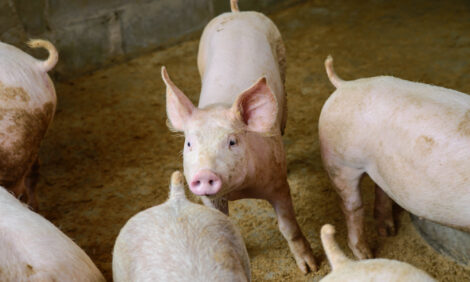



Pork Commentary: US and Canada Inventory
CANADA - This week's North American Pork Commentary from Jim Long.Last week the last quarter’s United States – Canada USA inventory report was released.
| September Report USA - Canada Hogs and Pigs Inventory based on 1000 head |
|||
| 2007 | 2008 | 2009 | |
|---|---|---|---|
| Kept for breeding | 7,752 | 7,478 | 7,227 |
| Market | 73,883 | 73,463 | 71,219 |
| Sows Farrowed | 3,927 | 3,848 | 3,698 |
| Pig Crop | 36,681 | 36,819 | 36,028 |
Our Observations
- United States and Canadian breeding inventory was 7,752 on the combined report September two years ago. Since then our industry has had almost continual losses with estimates reaching up to $7 billion in industry wide financial losses. Therefore it is not really surprising. The combined breeding herd has declined 525,000. In the last quarter from the June Report our combined breeding herd decline was 115,000. The sad part is these are not just numbers but a story in itself of people not having the capital and/or courage to continue. It is nothing to be proud of the failure of pork demand. So many good people have left this business. Too many producers’ dreams and futures have been dashed by crushing financial losses.
- The combined United States – Canada market inventory is down 2.224 million head from a year ago. (we had predicted 2.3 million). The combined inventory was also down 2.664 million from two years ago. If we assume 27 weeks to get a hog from birth to market (189 days). If we divide 2.224 million head decline by 27 weeks we come up with an average combined weekly marketing’s of 82,000 head fewer year over year in the coming six months. (of note: US hog marketing’s last week were 85,000 less than the same week a year ago). Bottom line: approximately 82,000 fewer week upon week is significant and will be price supportive.
- If we take combined pig crop last quarter and multiply by four quarters and divide by breeding inventory we come up with a production trend line. We did it for the three years.
| 2007 | 18.92 |
| 2008 | 19.69 |
| 2009 | 19.94 |
These are not absolute or totally accurate but certainly show there are major productivity gains ongoing. This helps cost of productions but certainly puts more pork on the market. Circo virus vaccines and rapid gains in utilitization of prolific genetics are major contributors of this increase.
- We believe the combined United States – Canada inventories are quite important. A continental market with trade in live pigs and pork makes the total supply a significant driver in price directions. It’s the reality of market interdependence.
Market News
- China announced last week that it would begin trade again with US for pork imports. It had been stopped for H1N1 reasons for several months. We do not expect this in itself to be a panaceato push markets higher but it should help. The most recent prices we have for China are approximately 95 cents US per pound lean price (live weight 74 cents). Prices that obviously we would love. There are reports from China that Blue Ear (prrs, circo, etc...) is again hitting production to a greater extent. Lean prices of 95 cents – you know that is a reflection of supply and demand. With our lean price of around 50 cents per pound there will be entrepreneurs who will figure out how to get some US pork into a 95 cent lean market. China’s acceptance of US pork is price supportive but it will not likely bring the price surge we saw fifteen months ago from huge sales to China.
- Russia - African Swine Fever has moved from the southern Caucasus region to the northern region of Russia – a jump of 1,000 miles. This could lead to large scale herd eradication. It is not happening yet, but something to watch – closely!!!
- Mexico’s slaughter prices have weakened somewhat down from 19 pesos to an average of 16.5 in Mexico City which is still approximately 56 cents US live weight per pound. The $40.00 per head plus difference between US and Mexico’s price is a reflection of the huge decline in Mexico’s breeding herd (down from one million to approximately 650,000 in the last two years). The price spread between Mexico and the United States will continue to enhance Mexico’s importation of pork from the US.
- The US lean hog price year over year is about 6 cents lower than last year. It’s narrowing, at some points it was 20 cents plus lower year over year. Maybe demand relative to supply is starting to move to a better place.
- The DTN – Agdayta calculation of what you can pay for 40 pound feeder pig is now $44.00. At the first part of August the calculation was negative. In the last ninety days a $44.00 plus increase. A reflection of better lean hog futures. In midsummer there were no months in 2010 that lean hog futures reflected anything but financial losses at current cost of productions. Things have gotten a little better with April through August lean hog futures (5 months) now in profit territory. Unfortunately it’s still 5 months until April.
- The latest US sow marketing’s were just over 66,000 for the week. Sow liquidation has slowed, it is still happening but not at the 9,000 a week we averaged last quarter.
Summary
The combined United States – Canada inventories reflect continual decline in continental production and supply. China’s opening to US pork is price supportive. Unlike some commentators paid by the NPPC, we do not believe lean hog futures are overvalued. We believe as H1N1 domestically and globally becomes a memory by the spring and summer coupled with a domestic and global economy coming out of a recession, there is room for higher lean hog futures. That being said, everyone has their ability to take risks. No one has gone broke from taking profits.









